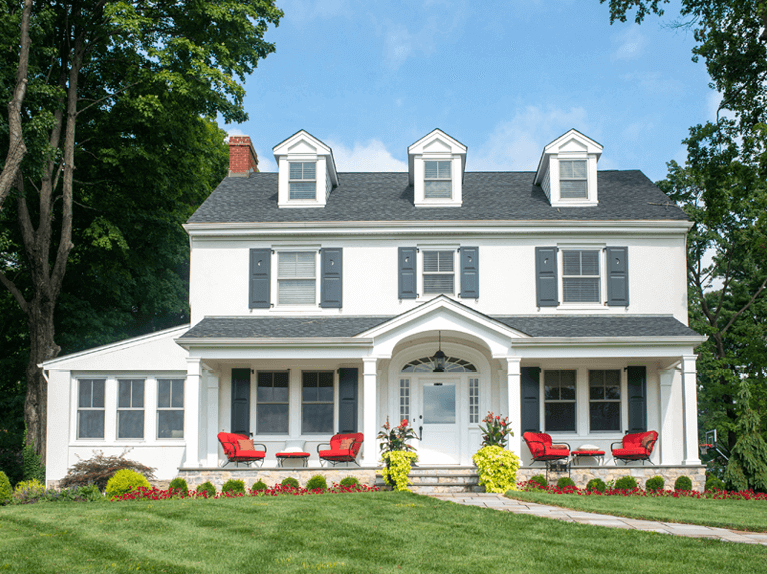Is stucco a good siding choice for your home? Let’s find out!
For centuries, stucco has stood the test of time as one of the most beloved siding options for homes. Its timeless appeal and durability have made it a top choice among homeowners looking to enhance their exteriors. Its smooth, plaster-like surface creates a sense of elegance and sophistication, while providing protection from the elements. Stucco’s versatility allows it to be used in a variety of architectural styles, making it a classic and reliable option for any home.
A staggering 25 percent of newly constructed single-family homes boast stucco siding, as reported by the Stucco Manufacturers Association in 2019. Surprisingly, this places it second only to vinyl as the most popular siding option in the United States. But what makes stucco such a top choice for homeowners? Let’s delve into its allure and appeal.
What Is Stucco?
Stucco, a versatile and durable cement-based material, is meticulously applied to the exterior of homes in multiple layers, building up to a thickness of about one inch. Its texture varies from smooth and sleek to textured and rough, depending on the chosen application technique. This adaptable product can be used over both masonry structures and wood frames, making it a popular choice for home exteriors.
Traditionally made with a combination of cement, lime, and sand, stucco has evolved over time to include newer systems such as acrylic, insulated, and crack suppression options that address common issues like cracking. These advancements not only provide added durability but also offer even more choices for varying textures. While stucco is widely popular in Southern and Western regions of the United States, its use is expanding to other parts of the country as newer products continue to improve upon traditional stucco’s limitations.
Advantages of Stucco
- Durability: Unlike other siding materials, stucco has some serious staying power. When properly applied, it can last for decades without needing maintenance. According to a Department of Energy study, Properly applied stucco will have a useful service life of 100 years.
- Appearance: Stucco offers unlimited customization. The finish can be anything from super smooth to highly textured. It works well with many architectural styles and other building materials, and can be tinted a range of colors.
- Fire resistance: Stucco provides a strong firewall rating — one hour — which makes it appealing when you need to meet local fire codes.
- Cost: Because applying stucco requires a high level of skill, the cost will vary regionally with labor costs. In the West, conventional stucco costs about $20,000 for a 3,000 sq. ft. home. The newer acrylic systems cost about $25,000 to $30,000. Acrylic stucco is probably going to be more cost effective than traditional wood, vinyl and composite siding. That’s due to its high durability, low maintenance needs and long lifespan.
Disadvantages of Stucco
- Cracks: If applied correctly, stucco should perform well. Hairline cracks are normal with conventional stucco, and stress cracks can occur as homes settle. But the newer acrylic stucco products and crack suppression systems have greatly decreased cracking.
- Insulation: Conventional stucco doesn’t provide much insulation value. But with new stucco insulation systems, you’ll get better performance.
- Staining: If water runs down stucco, it will stain over time, and you could have larger issues with moisture damage. Use gutters and keep sprinklers away from stucco exteriors.
How To Apply Stucco
The process of stucco application begins with a base layer of house wrap or felt paper and lath. Using only their skilled hands and a trowel, craftsmen carefully apply three coats to create the desired texture and color. The first coat is smooth and even, serving as a foundation for the subsequent layers. The second coat adds dimension, with subtle ridges and valleys forming under the skilled manipulation of the trowel. Finally, the third and final coat brings the surface to life with its chosen color and texture – whether it be a rustic, earthy finish or a sleek, modern sheen. Each stroke and curve of the trowel is expertly executed to create a beautiful finished product that will protect and adorn the exterior of a home for years to come.
Can You DIY Stucco or Should You Hire Someone?
The art of applying stucco is a rare skill possessed by only a select few homeowners. It requires a delicate touch and precise techniques, as even the smallest mistake can ruin the entire application. But it’s not just about skill – there are also challenges that come with the process, such as the need for specialized tools and equipment. This is not a task that can be done alone; it takes a team of three or four individuals working in unison to achieve perfection. Only then can the rough exterior of a building be transformed into a smooth, elegant surface that radiates sophistication and craftsmanship. And those lucky enough to have this knowledge and ability should be celebrated, for they possess a true talent that sets them apart from others.
Taking Care of Stucco
- Inspect stucco annually for cracks or damage and repair them as soon as possible so water doesn’t seep behind the stucco finish.
- Stucco typically doesn’t need cleaning. If it’s particularly dirty, hose it off using mild pressure.
- Use gutters and check them periodically to make sure they’re not clogged, damaged or leaking water onto the stucco. Repair gutters as soon as you spot issues to avoid damage or staining.
- Over time, the color may fade. You can paint stucco to refresh it.
- Trim trees and shrubs so they don’t rub against the stucco.
- Don’t put planters that hold water, such as window boxes, against stucco.
- Keep soil levels around the perimeter of the home below the stucco finish. Stucco is porous and can draw up moisture from any soil touching it.
- Use drip irrigation systems around the perimeter of the home. Avoid sprinkling or spraying water onto the siding.
